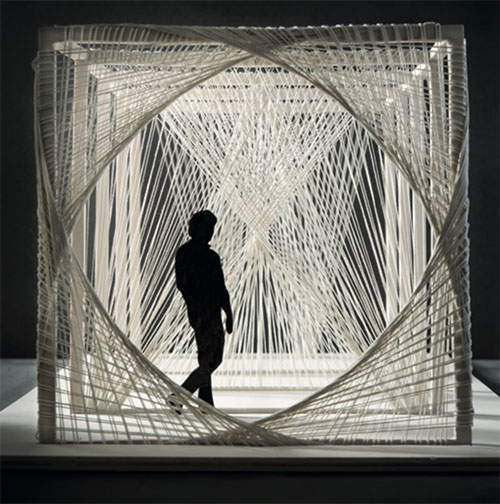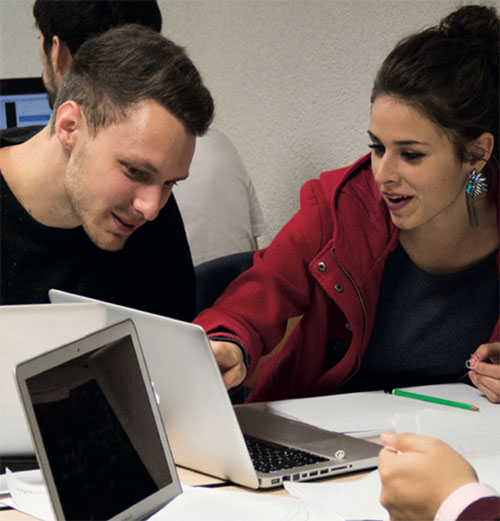
© Marie Contreras
Open Day and Information Sessions being held in June.
Following the arrival of its new Director, Patrick Parquet, in 2012, the design and communication school, IPAC Design Genève, has undergone a major overhaul – not just in terms of the courses offered, but also how they are taught, and who teaches them.
Eager to present his new school to both the local and expat communities, Patrick is holding a series of Information Sessions in June as well as a special Open Day on Saturday 4 June 2016 where visitors will have the opportunity to see presentations on the different courses available, meet the teachers who are delivering the courses, and request tours of the school.
So how has the school changed in the 4 years that Patrick has been at the helm? Knowitall.ch went to visit IPAC Design Genève at the beginning of May to find out more.
Without doubt, one of the biggest transformations to the school can be seen in the teaching staff. Lessons are now taught by professionals working in the the fields of Digital Media, Graphic Design, Interior Design and Fashion Design. Far from teaching purely academic disciplines, these creative professionals have been tasked with providing students with the toolkits they need to work in industry. So not only do they leave the school with a recognized qualification within the design and communications industries, they also have the skillset to get started on the job straight away. So employers know when they recruit students from IPAC Design Genève, that they won’t need to spend hours training them on the job.
Patrick explained, “Having worked in the advertising industry for 25 years, most recently as Creative Director within the DBB Group, I know only too well the difficulties that employers face trying to recruit creative staff with innovative ideas that they can apply in the work place. All too often, new recruits are simply unable to apply the technical skills that they have learnt at college. Or their teaching has been so blinkered that they simply don’t have the ability to think for themselves.”
He concluded, “So when I took over IPAC Design in 2012, my mission was clear: to provide a design environment, which fosters the development of students’ talent, and prepares them for the real world under the expert guidance of experienced design professionals. My goal is to create a dynamic school, that can respond to the changing demands of the 21st Century workplace.”

© Cynthia Cornu
Course schedule
Under the new course structure of the school, IPAC Design now offers 5 Europass Bachelor degrees for students, who have left school around the age of 18 and completed a recognized course of study. The design school also has a special BTEC National Diploma program for children aged 16 years above, as well as evening courses for adults already working in the design and communication industries.
Europass Bachelor Degrees
The 5 main Bachelor Degrees offered by the school are taught over 3 years. During each course, students receive help applying for an industrial placement, where they are expected to prepare CVs and motivation letters as well as a creative portfolio. Upon successful completion of the Bachelor Degree course, students earn 180 credits under the European Credit Transfer System – the standard number of credits for a Bachelor Degree awarded by universities in Europe. In addition, IPAC Design Genève students receive the Europass Diploma, a series of documents that makes the skills and qualifications attained by the student more clearly and easily understood throughout Europe.
The five Europass Bachelop Degrees offered by IPAC Design Genève are:
- Interactive Design: Digital design in the widest sense, the creation of mobile apps and websites, marketing and digital strategies, interactive communication, and social media.
- Communication Design: Visual creation, branding, communication, marketing strategy, and digital media.
- Interior Design: Practical application of theoretical concepts, learning how to master technical knowledge and tools for creative or interior design projects.
- Fashion Design: Materials, volume, colour, technical drawing, image and illustration software. In three years, students are expected to become complete fashion designers, mastering the fundamental techniques of sytling and modeling.
- Communication, Media and Strategy (provided in conjunction with the Academy for Marketing and Communication, Polycom SAWI): Focus on the transmission of knowledge and know-how in the communication, marketing and media fields.

© Création, photo Jade Righini
BTEC National Diploma
Targeted at children from the age of 16 years, the BTEC National Diploma in Art & Design is taught over 2 years and includes a foundation year, followed by optional modules in Graphic Design, Photography and Video. This diploma is a British qualification, recognized in more than 24 countries throughout the European Union, the USA, Canada and Australia. Much of the course work is “hands-on”, preparing students for the real world or further training on a Bachelor Degree course.
Evening courses
Two evenings per week are required for the evening classes, which are taught over one year, in 6 modules of 36 hours each. Three certificates are currently offered, namely Interior Design, Graphic and Web Design, and Fashion Design.
Why IPAC Design Genève?
So what makes IPAC Design Genève special compared to the many other design and communication schools available, not just those in the neighboring region, but also those further afield in Europe and beyond? Patrick told us,
“There are many reasons why students should choose IPAC Design Genève. First and foremost, we ensure that all our students leave with the tools they need to get a job. This includes not only industry-specific skills, but language skills as well. We aim for all our students to be proficient in both French and English when they qualify. This means that if they speak French or another language when they arrive, they will learn enough English to help them apply for jobs where English is required. Likewise, if they are English-speaking, they will pick up enough French during lessons and through contact with fellow students to enable them to conduct an interview in French when they leave! We currently have 44 nationalities at our school; our student mix is about 50:50 anglophone:francophone. Most of our teachers are French or Swiss but speak English fluently, although we have a new teacher arriving in September who only speaks English! We are not quite bilingual yet – but we are heading there!”
Being a member of the Swiss Design Association is one of the key benefits of the school that will help many students applying for jobs in the future. Being educated in an establishment linked with one of the top design associations in the world, in a country that holds one of the highest reputations for innovative design, can only help to increase the chances of IPAC Design Genève students as they set out on their chosen career paths.

A key attraction for many students attending the school is its small size. With around 180 students, and a maximum of 15 students on each degree course, the school is a friendly place to learn where everyone knows each other, occasionally working together on collaborative projects, which span across all years. Among many of the younger students on the BTEC course, there are children who have struggled through school, for a variety of reasons, but often because of a specific learning difficulty such as dyslexia. “We really want these kids,” says Patrick. “They have a unique way of looking at a creative problem and are often our most innovative designers! For many, the opportunity to be creative is a powerful boost to their self-esteem – gone are the days of poor attainment at school. Everyone has the ability to think creatively – the challenge for our teaching staff is to identify exactly where that creative talent lies and to nurture that talent to the point where it becomes a useful skill, that can be applied in a real-life situation in the workplace.”
According to Patrick, he makes it a goal to know all new students by Christmas of their first academic year. “When we are setting up industrial placements for our students, and using our network of contacts to help them get jobs, it’s important that we know our students well, not just on a professional level but personally too. Our reputation as a design and communication school is built on providing good quality students, and we will only maintain that reputation if we understand our students needs and can find the best match for them in the workplace.”
IPAC Design Genève is currently situated on the Rue Grande Pré in Geneva. However, plans are afoot to move the school next year to more spacious, modern premises in Geneva. Watch this space…
In the meantime, if you would like to find out more about IPAC Design Genève, please visit the website at www.ipac-design.ch and sign up for one of their upcoming information evenings, or their Open Day on 4 June 2016.
IPAC Design Genève
58 Cour
Rue Grand Pré
1201 Geneva
022 700 56 55
www.ipac-design.ch
Information Evenings
Wednesday 1 June 2016, 19h
BACHELORS EUROPASS Interactive Design
BACHELORS EUROPASS Communication Design
BACHELORS EUROPASS Communication Médias & Stratégie
Wednesday 8 June 2016, 19h
EVENING COURSE Fashion Design
EVENING COURSE Interior Design
EVENING COURSE Graphic and Web Design
Wednesday 15 June 2016, 19h
BACHELORS EUROPASS Fashion Design
BACHELORS EUROPASS Interior Design
BTEC National Diploma in Art & Design
Open Day
Saturday 4 June, 10h to 15h
Presentations on courses, meetings with teachers, tour of the school







